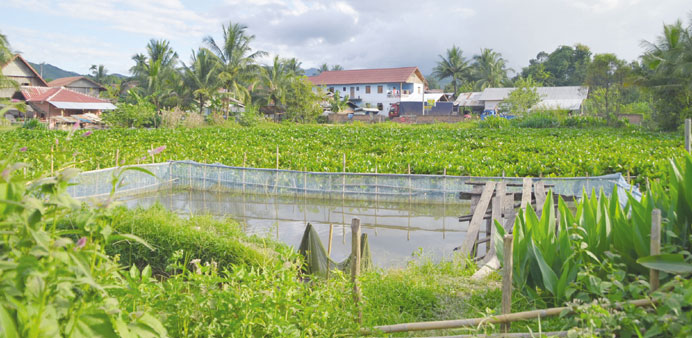Vegetable, herbal gardens and fish ponds are seen in Laos. The small landlocked country, one of the poorest in Southeast Asia, has come in the spotlight of foreign investors in recent times because of its unlocked agribusiness opportunities.
The small landlocked country of Laos, one of the poorest in Southeast Asia, has come in the spotlight of foreign investors in recent times because of its unlocked agribusiness opportunities, a fact that is of special interest for Middle Eastern country with regards to their food security strategies.
Laos is still an agriculture-based society, with about 33% of GDP accounted by farming. However, most of it is still produced for domestic use, and there is a notable absence of large multinational agribusiness companies in the country. It is estimated that up to half of Laos’ territory are untouched forests and land areas suitable for farming a variety of crops.
Between 2005 and 2011, just between $1.1bn and $1.7bn has been approved for projects in the agriculture sector by the Laos government, according to official figures. Experts from the Asian Development Bank feel that there is still a lot of potential in the sector.
However, Laos – unlike the Philippines – is reluctant to open its agri-sector to large multinationals because of its balanced community and rural development policy, due to environmental programmes and the country’s aim to position itself as a quality instead of a mass producer.
In its National Socio-Economic Development Plan for the period 2011–2015, Laos has prepared a strategy for agriculture, natural resources and rural development, as well as an agriculture development strategy. The government aims at promoting further foreign investment in the agriculture sector to foster growth, reduce poverty and develop the agriculture sector in line with the Millennium Development Goals. Every investor should keep in mind that an engagement in the Laos agriculture sector would include working towards such targets. The new rural strategy has a strong focus on modernising agricultural production and creating value-added food and agricultural products aimed at reducing rural poverty, maintaining food security and applying science-based management to natural resources.
The strategy seems to be successful so far. Fresh produce from Laos has attracted interest from organic food traders and consumers in Asean, Japan and Europe in recent times. Fresh vegetables, herbs and fruits from Laos are highly sought after, as well as coffee and corn.
Foreign investors could see a foray into Laos’ agricultural sector mainly as a quality investment. Since the country established its “good agricultural practice programme” in 2011, which focuses on environmental standards that include reduction of the use of fertilisers and agrochemicals, as well as sustainable irrigation and biodiversity, farmers in Laos have benefitted from the compliance of this practices with similar standards in Asean and European countries.
However, the biggest problem for international trade of Laos’ agricultural produce remains lacking infrastructure. The transport system in the country still needs a lot of improvement to trigger trade flows from which the rural population would really benefit in the long run. The government has placed strong emphasis on improving transport links, but progress is slow. Improvements have been made on key national and regional axes, such as the east-west corridor connecting Thailand to Vietnam through Laos and the north-south route from China to Thailand. But much more needs to be done.

